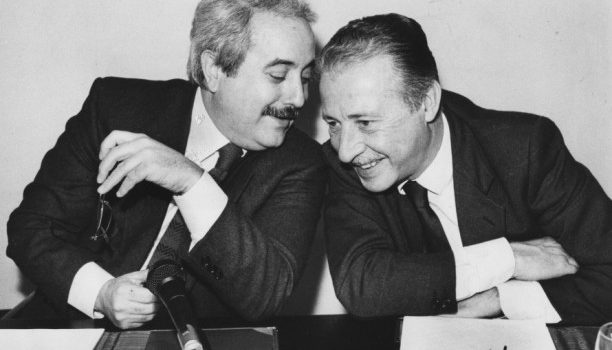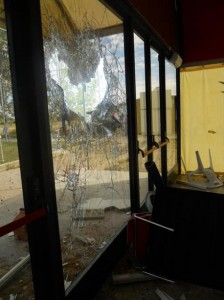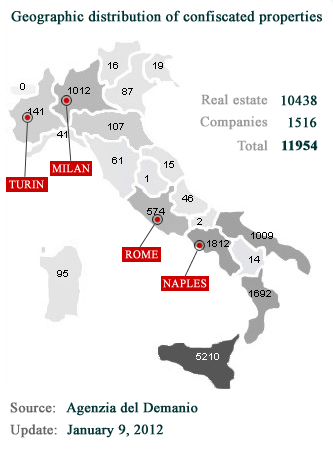

Facing down the mafia
in English 02/03/2012 Lorenzo Bodrero

Casal di Principe, a small hamlet 12 miles north of Naples, lies in a corner of Italy known, sadly, more for organized crime than for the delicious mozzarella goat cheese it exports worldwide.
But Casal di Principe is also on the front lines of a growing battle over a law aimed at ending the mafia’s stranglehold over the country. The law–unmatched anywhere else in the world–takes asset forfeiture one better: it hands over properties seized from the mafia to civic groups, many of them dedicated to the mafia’s eradication.
In recent months, the mafia has begun striking back with fury at the seized properties it had once owned. It has vandalized buildings and equipment, set fire to them and threatened their new owners, who are putting these assets to more productive uses.
“We are at war,” said Valerio Taglione, the regional coordinator of Libera, a nationwide non-profit network of 1,200 associations, civic groups and schools dedicated to fighting the mafia. “It is a war between two opposite cultures.”
Taglione’s Cooperativa Eureka, where two dozen young people with mental illnesses cultivate wine and grow vegetables, recently saw its water system destroyed. The culprits: mafia recruits eager to establish their criminal bona fides. Cooperative Eureka is located on land once owned by a mafia clan’s boss.
“It’s a sort of training,” said Taglione, who also oversees a similar property in nearby Caserta. “It helps them gain the respect of their bosses, just like going into prison.”
Taglione is a prominent figure in the Naples area, giving anti-mafia classes, seminars and economic initiatives on properties confiscated from criminal syndicates by law enforcement officials. The attacks, he said, frightened the youngsters at Eureka.
“The local Camorra won’t give us a rest,” said Taglione. “The boys are scared, of course. Yet we do notice a slow but constant change in the mentality of local people.”
Fortunately, Taglione is far from alone in standing up to organized crime syndicates. Lawyers, ordinary citizens and businessmen, as well as journalists , are also on the front lines against a criminal movement long emblematic of Italian life. My own role opposing the mafia began five years ago.
Through it, I know Libera well. The association where I work, FLARE (Freedom Legality and Rights in Europe) is an outgrowth of the Libera, and part of a grassroots network linking nongovernmental organizations from 25 European countries combating organized crime. FLARE seeks to replicate across Europe what Libera has accomplished in Italy over its 20-year history.
It’s a slow process – but one with highly achievable outcomes. Organized crime’s first goal, according to Italian prosecutors, is manipulating financial resources for enormous profits. The next step is consolidating political and, finally, social control over a territory. Thus, mobsters enjoy flaunting their power and wealth.
This is where organizations like Libera and FLARE come in.
A nation of laws
Italy stands tall in the breadth of its measures tackling organized crime. One is “Rognoni – La Torre,” legislation enabling authorities to seize assets of criminals convicted of “mafia conspiracy” – along with their relatives and affiliates. Their properties, in turn, are handed over to community groups – like Libera – who use them as a base for anti-gang activities and for programs for people who are unemployed.
The strategy behind Rognoni-LaTorre is only partially economic. Targeting motivations is essential. “We have to deprive them of the very reason behind every crime,” explains Francesco Menditto, a prosecutor and former Naples judge. “Even more [important] is the symbolism behind depriving a ‘mafioso’ of his luxury house, a piece of land, a factory, cars and boats.”

The Villagio Legalita, a former mafia property turned over to a civic group, vandalized by the mafia last fall. Photo: Corriere della Sera
“Each confiscated asset is a clear message to mafias, saying ‘you have been defeated,’” he added. “They hate that – it undermines consensus and the grip over the territory they control.”
To date, nearly 700 onetime mafia properties are now central to community-oriented projects nationwide – out of nearly 12,00 seized assets. Shelters, youth hostels, cooperatives and fruit and vegetables farms operate on lands and buildings once owned by the mafia.
But the greatest vulnerability of these programs lies in the fact that they are located in regions that remain in the mafia’s grip.
A dangerous reality
Consequently, journalists and other anti-mafia crusaders who champion such community efforts often find themselves in the crosshairs. Intimidation and outright violence have been the mafia’s tools of choice. Nine reporters have been slain in recent decades, and their families regularly face threats and attacks. Censorship from public officials, and colleagues, meanwhile, remain a constant.
They join thousands of other Italians who, in their overall efforts to combat or expose the Mafia, have paid heavy prices – often with their lives.
But Italy’s Mafia asset-confiscation programs are special. Not only do they offer unique perspectives into organized crime itself, they also showcase a people united to end a crime wave threatening the very fabric of their society.
The birth of a movement
Like so much of Italy’s anti-mafia movement, its asset forfeiture laws are rooted in bloodshed. The law itself, “Rognoni-La Torre” was named for Pio La Torre, an Italian Communist Party leader from Sicily. In 1982, after gaining fame for promoting innovative mafia-combating measures in parliament, La Torre died in a hail of bullets.
His assassination was followed by the killing of another anti-mafia crusader, General Carlo Alberto Dalla Chiesa, in Palermo, later that year. The deaths prompted parliament to adopt the “Rognoni-La Torre” law along with other emergency measures.

For a decade, however, the legislation languished, until the early 1990s witnessed a resurgence in mafia-related killings of government officials and internal feuding. The 1992 slayings of activist judges Giovanni Falcone and Paolo Borsellino, most notably, shook the nation to its core and galvanized public opinion.
Twenty years on, I still remember the Falcone killing clearly. As a 12-year-old, I had never heard of Falcone, but there was no mistaking his importance when my father, driving me to school that morning, pulled over to listen to the radio, his eyes filled with concern.
The killing of Falcone and Borsellino also led to the founding of Libera, which represents all strata of society – from police and lawyers to social workers, politicians, youth activists and ordinary citizens. Libera’s first act was collecting signatures, which gave parliament the impetus to strengthen the “Rognoni-La Torre” laws and allow for confiscated mafia asses to be turned over to community groups for socially-beneficial purposes.
Through my own work, I have visited several confiscated properties. One is a beautiful hilltop villa some 25 miles from Turin, my hometown in northern Italy, a place with a reputation for being “civilized.” But this part of the country, often deemed so different from the south, is considered the mafia’s second home.
In the north, the media seldom speaks of the mafia. Yet money laundering has made it a conspicuous epicenter of enormous financial power. This particular villa once belonged to the Belfiore family, from the ‘Ndrangheta clan of Calabria, one of the most powerful syndicates in the country. It was none other than Domenico Belfiore who ordered the 1983 assassination of a magistrate named Bruno Caccia.
Today, the villa, now named “Cascina Bruno Caccia,” also managed by Libera, is a place where young people gather to cultivate and sell organic food. In this free piece of land, the mafia has been defeated.
Organized defiance
Elsewhere, though, Italy’s mafias remain defiant. Last October, for instance, vandals demolished a newly-renovated community center in Borgo Sabotino, a small town 40 miles south of Rome. The structure, formerly owned by criminals, was a money laundering site, too. The 10-acre piece of land had been handed over to Libera after being seized by the Italian government.
Libera had turned it into the “Villaggio della Legalità ,” or “Village of Legality,” a place where associations, youth groups and non-governmental organizations meet to develop projects advocating the rule of law.
Windows, doors, tables, desks and computers as well as sound and video equipment were ransacked and destroyed.
Criminals see Libera’s use of their property as an affront. As if to underscore their point, the attack unfolded the day before a seminar commemorating Father Cesare Boschin, a Catholic priest who was killed in a nearby town after denouncing illegal trafficking of garbage and waste by the local organized crime syndicate.
“Mafia affiliates – and bosses in particular – would rather spend time in jail than see their properties used for the sake of people,” said Menditto, the anti-mafia prosecutor. “They hate that.”
And while similar acts occur weekly all over the country, activists are resolute. “It’s a vile act,” Luigi Ciotti, Libera President and a Catholic priest said after the October attack. “Nobody will ever be able to stop our commitment. With tirelessness, passion and responsibility, many territories all over the country say no the Mafias – just like here.”
While many politicians quickly denounced the destruction at the “Villaggio,” they signaled no resolve to establishing a protective presence around the place. This stood in stark contrast to the efforts of Borgo Sabotino’s people. The night after the attack, 300 volunteers slept inside the building.
“True support comes from ordinary people,” said Antonio Turri, who manages the facility with some 30 volunteers aged 15 to 35. The message of solidarity, he recalled, was unmistakable: “We are not leaving, we rebuild what you destroy.”
The legacy of a legend
Back in Sicily there is a popular restaurant, “Pizzeria Peppino Impastato.” With some of the tastiest pizzas in the region, it carries the name of an Italian reporter whose name epitomizes the fight against organized crime.
Peppino Impastato, murdered in 1978 at the age of 25, was targeted by the mafia for anti-mob activities and supporting workers’ rights. Peppino’s fate was sealed after he shouted down the local boss on live radio. Kidnapped, laden with explosives and tied to a railway, none of his remains were ever found.
Instead, his soul lives on, inspiring today’s generations with associations, youth movements, cooperatives on confiscated lands and research centers.
But last December, just before Christmas, a mysterious fire ripped through the pizzeria, now managed by Peppino’s brother Giovanni. The cause of the blaze has yet to be determined but Impastato scarcely doubts its “intentional nature.”
Meanwhile Giovanni Tizian, another journalist who covers the mafia at great personal danger, offers a similar contemporary profile in courage. A “precario,” he is freelancer without a fixed contract – a sign of an economic climate denying him a steady job and future.
But the lack of steady income isn’t the only insecurity in his life. Earlier this month, thanks to his mafia reportage, the 29-year-old was assigned 24-hour police protection.
Tizian has personal reasons for his commitment. His father was an entrepreneur whose company was burned to the ground in 1988 after he said no to mafia extortion. The following year, he was killed by the ‘Ndrangheta syndicate; Giovanni Tizian was seven at the time.
The media has echoed his mother’s worries. “I cannot pretend I am not scared,” she told the director of the magazine Narcomafie. “But before fear come the respect and love I have for the life of my son.”
A nationwide commitment
When my colleagues and I reflect on these events, our thoughts are with those who work in these cooperatives, and to the tens of thousands who rally every March 21st, on Italy’s national day to commemorate victims of the mafia.
But our prayers also go out to many survivors, too – wives, children, husbands and families. These are people afflicted by violence who still bravely speak at schools to convey why everyone has a vested interest in seeing organized crime defeated.
This is a danger for the mafiosi – and they know it.
Just ask the residents back in Casal di Principe, who still cherish the memory of Father Peppino Diana. The local priest, a member of Libera, lost his life teaching local youth about democracy and the rule of law. After he was killed, local residents dedicated a park in his name.
But in November, vandals trashed the area, covering it in obscene graffiti. It was the third such incident in town that month.
Taglione and the others remain undeterred. “This land is not only Camorra’s land, it’s the land of Father Peppino Diana,” he said. “It’s a mentality we try and build every day – there is hope.”
